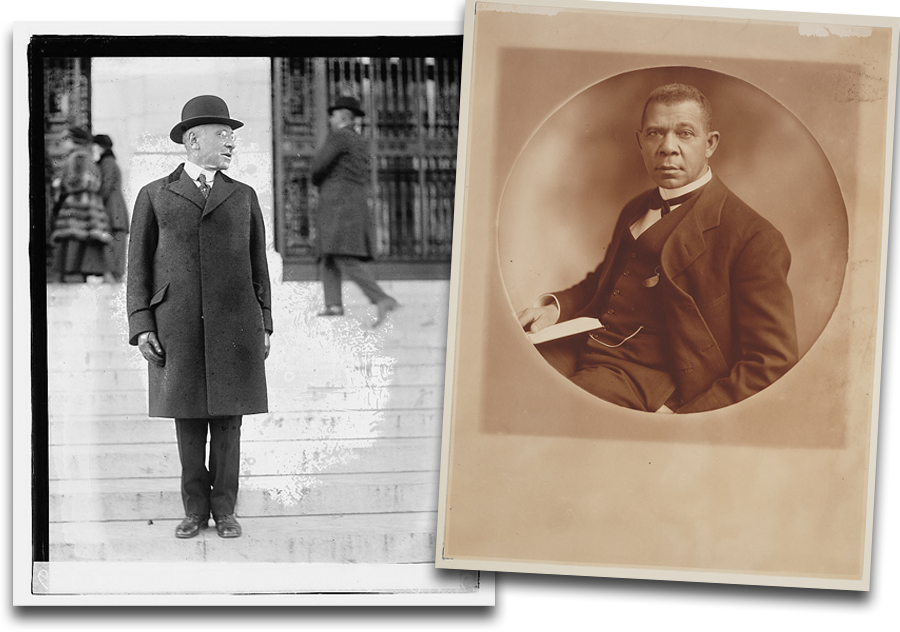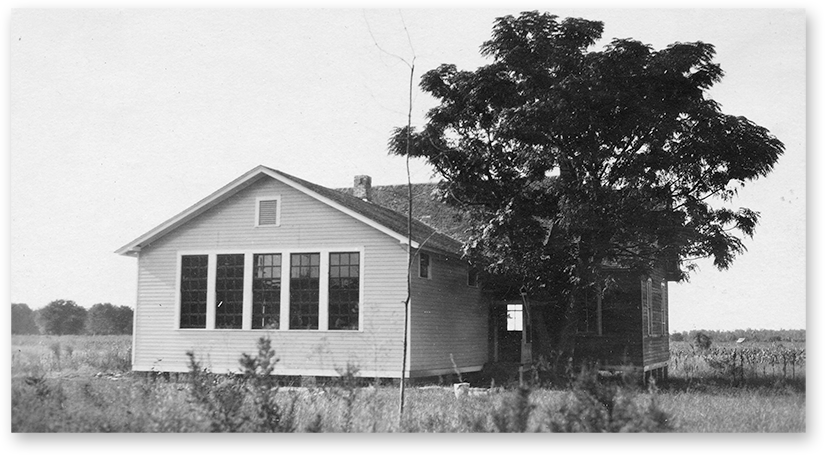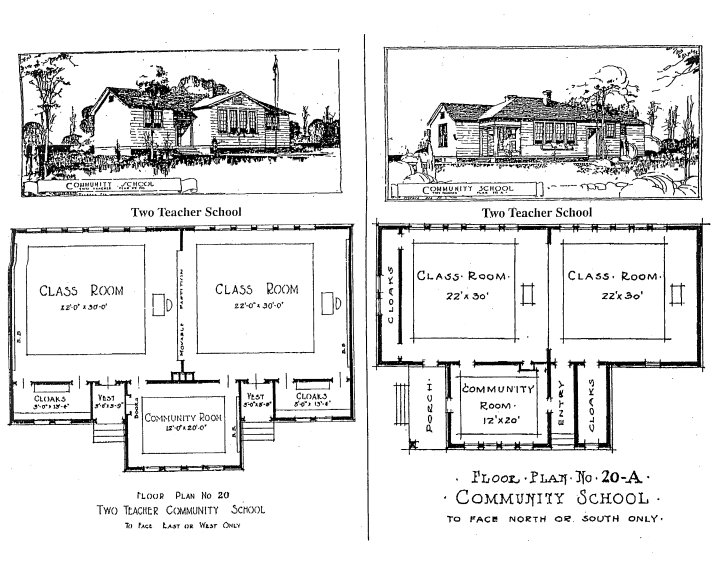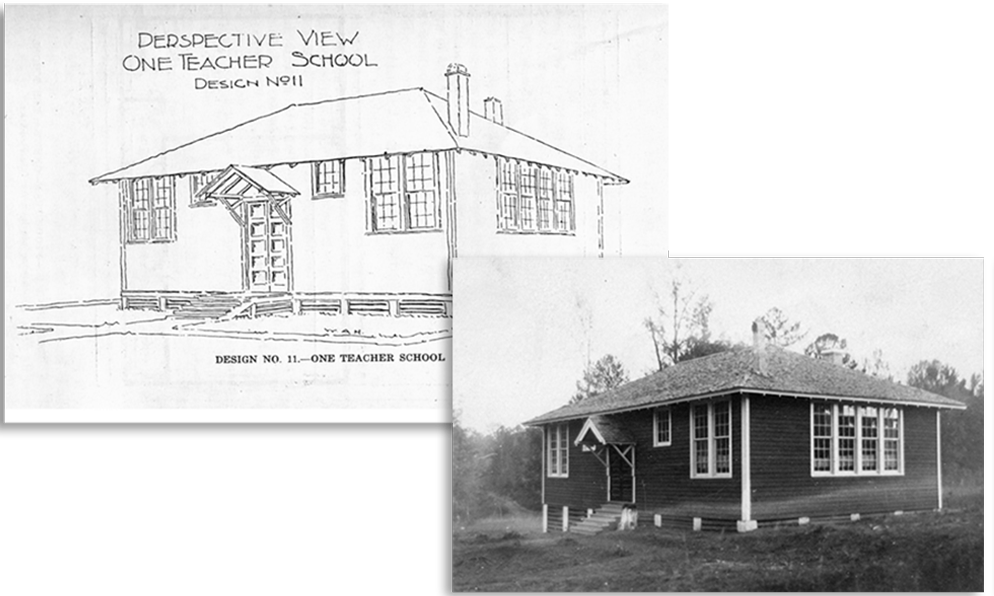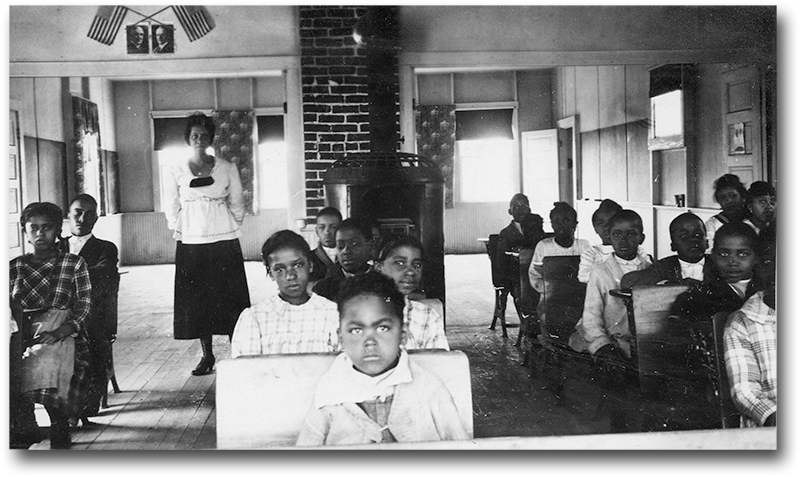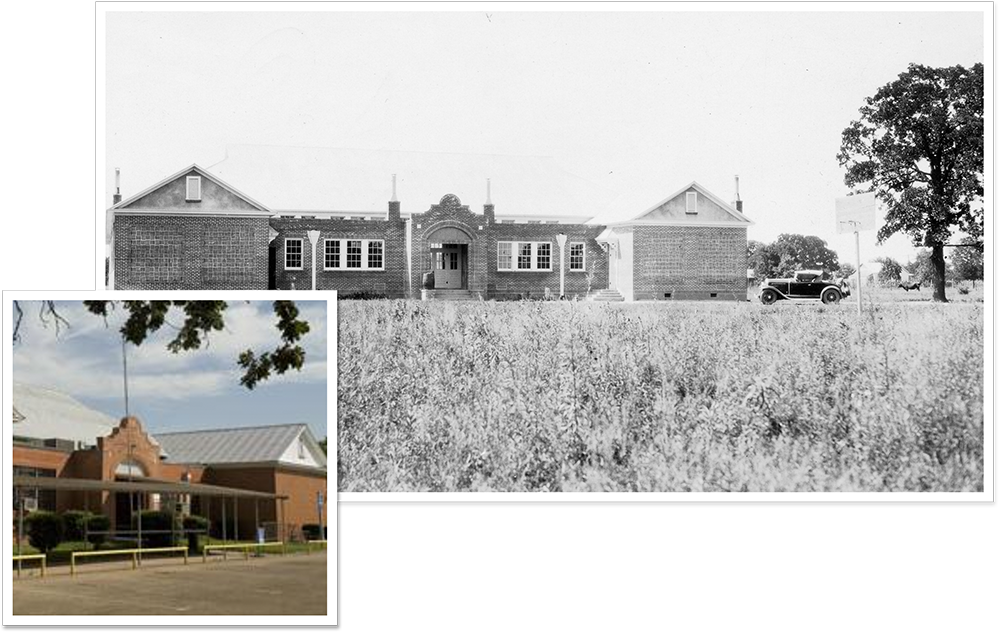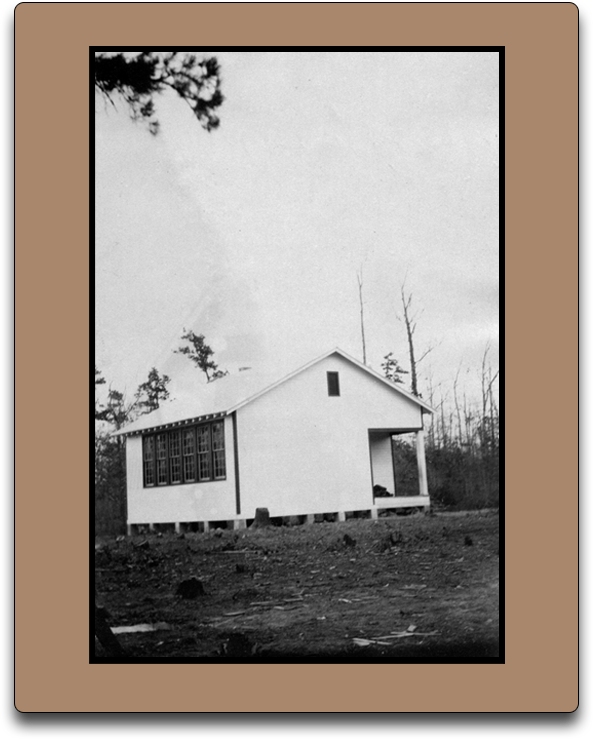Photo History: The Incredible True Story of How Booker T. Washington & the President of Sears Built 5,000 Schools for Generations of Southern Black Students
By Beth Hawkins | January 15, 2020
In 1910, Julius Rosenwald, president of the Sears, Roebuck mail-order empire, read Booker T. Washington’s Up From Slavery, an account of his emancipation and founding of the Tuskegee Institute, originally a school for teachers that became one of today’s most venerated of the Historically Black Colleges and Universities. Rosenwald recognized a kindred spirit, someone who, like him, was a fierce believer in the power of self-determination.
A friendship sparked, and over the next 20 years the two men would team up to build more than 5,000 schoolhouses in black communities across the South, where existing facilities, in Washington’s words, were “as bad as stables” — if there were schools at all. With a scope that would be deemed unattainable today, their audacious scheme is credited by present-day economists with having created “a new black middle class in the South.”
The unlikely partners — a former slave and a first-generation Jewish American from Chicago, a Northerner whose company was known for shipping home-building kits through the mail — provided funding, blueprints and guidance that enabled black communities in 15 states to build inviting, permanent places for their children to learn.
Every year, the Rosenwald Fund updated a map of its schools. This is the last version, showing schools in 85 percent of Southern counties that were home to school-age black children. Slightly expanded images of the eastern and western portions of the map can be found here. (Map courtesy of Rosenwald Fund/Historysouth.org)
Julius Rosenwald in 1919 and albumin print of Booker T. Washington taken around 1910 by Peter P. Jones (Photos courtesy Library of Congress)
The neglect the two men sought to surmount was fearsome. Macon County, home of the Tuskegee Institute, spent $14 on each white child’s education but just 20 cents on each black child. White schools had one teacher for every 30 students, while in the few existing black schools, each teacher was responsible for upwards of 200 students. This was what “separate but equal” meant.
Rosenwald Rural Schools Initiative funds were enjoined to require community buy-in and prevent local white officials from diverting the money from its intended purpose. The schools were designed specifically to compensate for a widespread lack of electricity and indoor plumbing. To enable rural communities to compete for scarce black teaching talent, there were blueprints and seed money for adjoining teacher housing and, later — practically unheard of at the time — high schools and facilities for “industrial” training.
The construction campaign ran from 1912 to 1932. The 1929 stock market crash, which decimated the Sears stock Rosenwald had used to endow the effort, was the first harbinger of the building boom’s end. But the schools continued to serve children for decades — ironically, until Brown v. Board of Education and other civil rights efforts saw black schools closed, their teachers dismissed and their students transferred to formerly white facilities.
By the time the initiative ended, it had helped to create 5,357 schools and associated buildings in 883 counties that educated 663,615 students — more than a fourth of black children in the South. The schools had an enormous effect on literacy, earnings and the Great Migration to the North, the Federal Reserve Bank of Chicago concluded in a 2009 report.
Today, an estimated 10 percent of the schoolhouses still exist — some as community centers and museums with plaques explaining their significance, others as barns and sheds, their historic pasts unrecognized. And there is a national campaign to restore and preserve these important remnants of American history.
What follows is a selection of photographs from an archive at Fisk University’s John Hope and Aurelia E. Franklin Library in Nashville, and from other institutions working to document the schools’ history, accompanied by short portraits of their communities.
Madison Park Rural School, Madison Park, Alabama, 1913
Viewed from the side of the building that housed the community room, the Madison Park Rural School had two classrooms, each flooded with light from a bank of five windows. Perhaps more than any other feature, these tall, contiguous windows are a telltale sign that a structure was a Rosenwald school.
Built according to plans drawn by architects at the Tuskegee Institute, the school occupied two acres of land donated by freed slave Eli Madison, a town leader who previously offered his house for use as a classroom. His daughter, Carrie Madison, was principal for 27 years. (Photos courtesy of John Hope and Aurelia E. Franklin Library/Fisk University; architectural plans courtesy of Rosenwald Fund/Historysouth.org)
One of the first Rosenwald schools was built in the hamlet of Madison Park, Alabama, founded in 1880 by 14 former slaves who had purchased 1,000 acres of the May Plantation. At the time of the town’s founding, it was illegal to educate a black person.
“They built grist mills, saw mills, two syrup mills, a cotton gin, grocery stores, a park and a gravel pit,” according to the Madison Park Community Re-Union Organization. “The community for all practical purposes was a self-sufficient community. In order to preserve the community for their descendants, they established a pledge among themselves that none of them would ever sell any land to a white person.”
The Madison Park Rural School was erected in 1913. Eli Madison, in whose house the first classes took place, deeded the land. Rosenwald and Washington shared strong feelings about the need to prod Southern authorities into investing in schools for black children, so to get a grant, both local black residents and white officials had to contribute toward a new school’s construction and operations.
Of the $950 cost of the Madison Park school, $500 was raised by the black community, $200 by white officials and $250 by Rosenwald. In addition to the incentive of drawing on philanthropic gifts and money raised by local blacks to begin to fulfill the mandate of separate but equal, white officials were often swayed by arguments that a better-educated black population was good for the local economy.
In what would become a distinctive architectural pattern, the Madison Park school was designed to accommodate two teachers. It had two banks of five double-hung windows, one for each classroom, and a folding partition that could be pushed aside to create one large space.
“Going to a Rosenwald school initially meant being in the vanguard of education for African-American children,” the National Trust for Historic Preservation explains. “The architecture of the schools made a visual assertion of the equality of all children, and the activities at the school made it a focal point of community identity and aspirations.”
By 1915, the Madison Park Rural School had enrolled 160 students. When it was replaced by a four-room cement block structure 40 years later, there were 200.
Sweet Gum School, Macon, Alabama, 1915

“Entrance vestibules and halls should be wainscoted four feet high complete with wainscoting cap, base and shoe,” a guide specified. “It would add to the beauty and utility of the classrooms without additional cost if wainscoting should be used up to the bottom of the windows. (Photos courtesy of John Hope and Aurelia E. Franklin Library/Fisk University; architectural plans courtesy of Rosenwald Fund/Historysouth.org)
In February 1915, Rosenwald took a group of philanthropists to Tuskegee to see six of the new schools. They stopped at each so he might speak to the students who came out to greet them, his grandson, Norman H. Finkelstein, wrote in a children’s history of the project, Schools of Hope. “Rosenwald noticed that homes near the schools were freshly painted or whitewashed,” Finkelstein reported, “a clear sign that the new schools increased community pride.”
A week later, Washington mailed Rosenwald a story from the Montgomery Advertiser about the group’s visit. “Unless you have lived in the South, as I have, you cannot know what this recognition on the part of the people of Montgomery means,” Washington wrote. “The mere fact that a newspaper of the character of the Advertiser would give such wide publicity to a Northern party that came South primarily to visit Negro schools, indicates more in the way of growth and tolerance than you can imagine.”
Weeks later, the Tuskegee Extension Department published a detailed guide to opening a Rosenwald school, “The Negro Rural School and Its Relation to the Community,” specifying everything from site selection to the width of window sashes, according to Stephanie Deutsch’s You Need a Schoolhouse.
The paint — builders had a choice of two tones — was barely dry on the first six schools when Washington died. In his honor, Rosenwald created a memorial fund that seeded an endowment for the Tuskegee Institute.
Coletown Elementary School, Fayette, Kentucky, 1921
This picture of students and their teacher at Coletown Elementary illustrates how the placement of the Rosenwald schools’ trademark windows and pupils’ desks was configured to cast sunlight over students’ left shoulders, so their writing hands would not create shadows across their work.
The pictures on the wall behind the teacher are characteristic of the minimal decorations prescribed by the schools’ plans: “One or two pictures of Negro leaders” and a U.S. flag. Though Julius Rosenwald discouraged use of his name, communities often hung his portrait, too. (Photos courtesy of John Hope and Aurelia E. Franklin Library/Fisk University)
In 1835, a Fayette County, Kentucky, slave owner emancipated a woman named Milly Cole. Eight years later, his heir left her 10 acres of the family’s land, worth $400. Around the parcel sprang up Coletown, which no longer exists but is remembered by descendants of its residents.
Kentucky had a constitutional requirement for segregated schools and a history of restricting tax monies to white schools, so Coletown had to turn to “subscriptions” to fund its school. In 1921, Coletown got a two-teacher Rosenwald school, one of five built in the county. Black community members put up $300, Rosenwald $800 and local officials the remaining $2,700.
Though the Rosenwald Fund would refine the plans, the schools’ design was carefully thought out. The large windows, for example, ensured that in the absence of electric lamps there would be plenty of natural light. Exposures should be precisely east-west or north-south.
The plans were also designed to prod local officials into making the separate facilities more equal. Rosenwald schools could not be built on swampy land or too near a railroad, for instance. Outdoor privies were required — sometimes with cut-up squares of Sears catalogues on a string for toilet paper — as was a room for “industrial” education and wide walks. Furnishings had to be new.
Black residents of communities seeking a school collected pennies, sold eggs and even felled and milled their own lumber to make their contributions. White contributions came, too, albeit not always strictly in support of black self-determination. With many blacks joining the Great Migration, local whites often hoped to keep black labor in the community.
Calvert County Training School, Robinson, Texas, 1929
The largest Rosenwald school built in Texas, the Calvert County Training School, was an expanded version of the fund’s “6-A” six-teacher blueprint. It had space for 12 teachers and a variety of vocational programs. Job training at the new high schools included farming, home economics and shop skills — trades deliberately chosen to not threaten white domination of the economic hierarchy.
In a departure from the fund’s airy but simple timber structures, the Calvert school was made of brick. The total cost was $26,500 — prohibitive for most communities. Yet the building was durable enough to serve as a school until 2010. Today, the Calvert Colored W.D. Spigner Alumni Association uses it as a neighborhood center. (Historic photo courtesy of John Hope and Aurelia E. Franklin Library/Fisk University; contemporary photo courtesy of Texas Historical Commission)
From the start, Rosenwald was concerned that philanthropy not become a mechanism for white officials to divert resources from black schools. In 1928, he made a major donation of Sears stock to the Rosenwald Fund — and announced it would have to spend all its funds and cease operations within 25 years of his death.
The fund also began constructing larger buildings that could offer high school programming, a rarity for blacks in the South well into the 1920s. Neither Alabama nor South Carolina had a single accredited, four-year high school for black children, and Florida had just two, according to the Federal Reserve.
Completed in 1929, the Calvert County Training School, located in Texas’s Brazos Valley, squeaked in under the wire: The stock market crash that ushered in the Great Depression hollowed out the value of the Rosenwald fund’s stocks. The building boom was over anyhow, and in later years the fund’s successors created teacher training programs at historically black colleges, seeded libraries and library programs at black colleges, and provided fellowships for black intellectuals and writers.
But while the building program lasted for only 20 years, its benefits were immediate — and long-lasting.
Using military screening records and other data, Federal Reserve researchers concluded that the Rosenwald schools significantly bolstered literacy, earnings and South-to-North migration among rural blacks.
“Ultimately, we estimate that exposure to Rosenwald schools increased relative wages of blacks that remained in the South by around 35 percent,” the researchers wrote in 2009.
“Moreover, these returns do not account for potential benefits of migration to better labor opportunities in the North. We estimate that Southern blacks who were between the ages of 12 and 16 in 1935 were about 65 percent more likely to migrate to the North by 1940 if they were exposed to Rosenwald schools.”
Shady Grove School, Gum Spring, Virginia, 1927
Built at a cost of $1,500, the Shady Grove School in Gum Spring, Virginia, followed Rosenwald’s “Nashville One Teacher Plan No. 1” for schools “to face east or west only.” In addition to specifying interior finishes, the fund laid out expectations for the grounds: tree stumps were to be removed, along with rocks and other debris that would impede plowing and landscaping. Appropriate shrubs and vines were suggested: “Grape, honeysuckle, clematis, wisteria, Virginia creeper and bittersweet grow best on fences and trellises.” (Photos courtesy of John Hope and Aurelia E. Franklin Library/Fisk University)
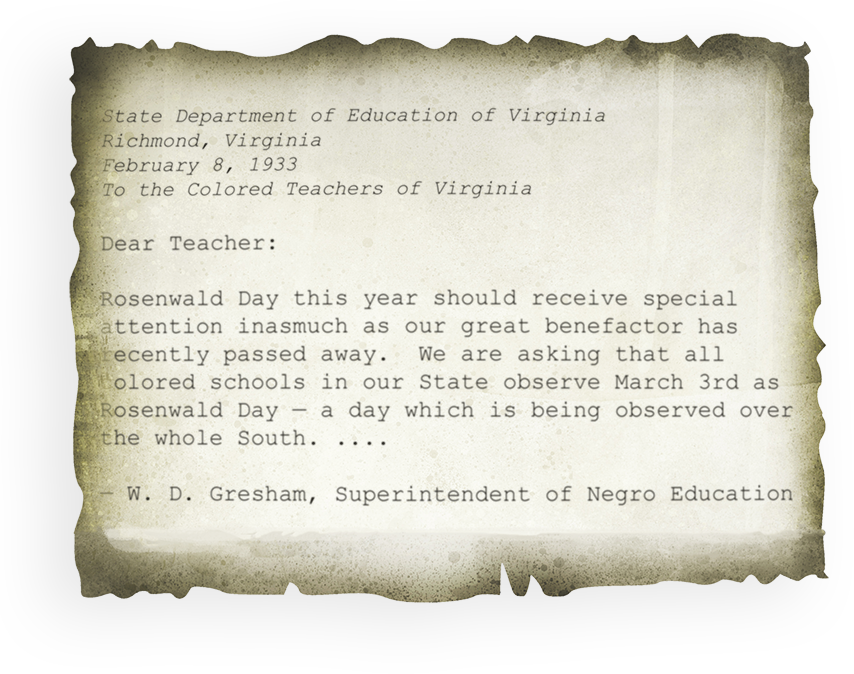
Though many Rosenwald schools continued to enroll students for decades, the push for desegregation ultimately spelled their downfall.
“In the late 1940s and 1950s, Southern states undertook massive school building campaigns in hopes of forestalling legal challenges in public school segregation,” the National Trust for Historic Preservation reported. “Desegregation, integration and new building standards inspired further new school construction.”
The court-ordered integration that eventually followed Brown v. Board of Education and passage of the Civil Rights Act of 1964 led to the shuttering of many more Rosenwald schools. Black students were transferred to white schools.
Many of the Rosenwald buildings that had not already been replaced fell into disrepair. Some were dismantled board by board and moved. Others were repurposed, but many simply crumbled. Estimates are that about 10 percent are still standing.
After 35 years of use by pupils in grades 1 through 7, Shady Grove closed in 1962 when its students were transferred to a school five miles away. The county sold the building to a man named Wilmore Shelton, who later sold it to the Shady Grove Baptist Church for $10.
In 2002, the National Trust for Historic Preservation put the Rosenwald schools on its list of most endangered historic sites. Four years later, a group of former Shady Grove students undertook the building’s restoration as a museum and gathering place. The Shady Grove Restoration Committee, a cross section of community members, was able to get the property listed both on the National Register of Historic Places and the Virginia Landmarks Register.
In 2016, the National Trust and the National Parks Conservation Association began meeting to consider a national park honoring Rosenwald and protection of the schools. In June of last year, legislation to fund study of the park’s creation was introduced in Congress.
The Rosenwald Park Campaign currently envisions a visitor center in Chicago dedicated to Rosenwald’s life and several school sites in the South, to be selected by the National Park Service. Shady Grove is under consideration.
The Columbia School, Brazoria, Texas, 1921
The Columbia School featured the trademark Rosenwald windows on its eastern facade. The west side had smaller windows, set high in the wall to block the afternoon heat.
After the school closed in 1948, it was sold and moved to a farm, where it was used to store hay. It was still standing nearly half a century later when local historians realized its significance and moved to save it. (Historic photo courtesy of John Hope and Aurelia E. Franklin Library/Fisk University; contemporary photo courtesy of National Trust for Historic Preservation)
In the 1990s, the Columbia History Museum, located in West Columbia, Texas, was planning an exhibit on education. Morris Richardson, the husband of a woman who was part of the effort, mentioned in passing that a rickety barn located nearby was in fact a Rosenwald school. Richardson knew this because he had taught in a Rosenwald school in Luling, Texas, where the district had replaced the original building but still operates a school bearing Rosenwald’s name.
After the National Trust designated the Rosenwald schools as endangered, the museum got a grant to study whether the Columbia School building could be restored. The Columbia-Brazoria Independent School District and several other community groups moved the structure to land behind the museum, where it was oriented exactly as the original plans dictated — to allow the trademark bank of windows to catch the light.
The community has identified dozens of alumni and now uses the building as an interactive children’s museum, where school groups and others can experience life in a one-teacher school.
“You will not leave here,” promises a video documenting the restoration, “without a deeper appreciation of education and its place in the community.”
With Layout and Graphics by Meghan Gallagher
Get stories like these delivered straight to your inbox. Sign up for The 74 Newsletter


